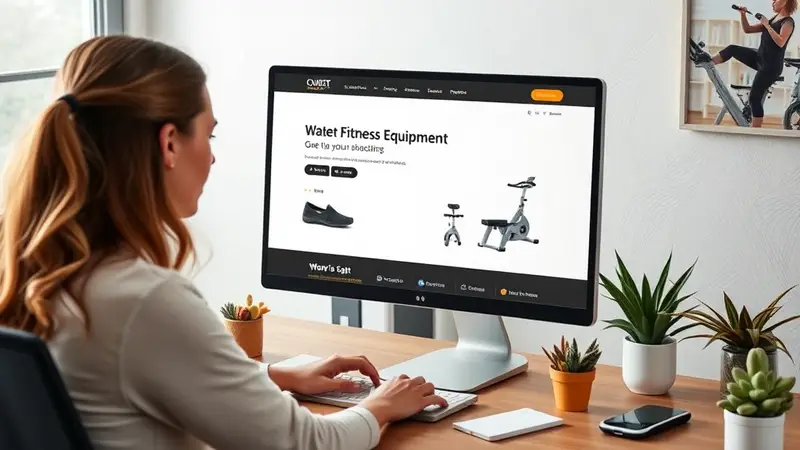Mobile devices have become integral to how people connect with businesses, conduct research, and make daily purchases. As this shift in consumer behavior continues to accelerate, companies are finding that traditional desktop-focused marketing strategies are not enough to capture the full scope of potential customers. Instead, marketers are turning to Mobile SEM campaigns to reach users on smartphones and tablets at the exact moment they search for relevant information.
Search engine marketing has always been about meeting customers where they are in their buying journey. Yet, for years, many campaigns centered on desktop users. In the current environment, customers may start a product comparison on their smartphone in the morning, continue their search on a laptop at work, and finalize their purchase on a tablet at home. To stay competitive, businesses need a strategy tailored to these new, fast-moving, and often shorter mobile interactions.
Mobile SEM campaigns help position a brand’s ads at the top of search engine results pages on mobile devices. By focusing on mobile-specific targeting, messaging, and landing page design, these campaigns ensure that potential customers get a seamless, user-friendly experience that increases engagement and boosts conversions. This introduction sets the stage for a deep dive into all the elements that make Mobile SEM campaigns successful, from precise keyword selection and budget allocation to ad copy and landing page best practices. Throughout this guide, you’ll discover how to optimize every step of your search engine marketing approach to align with consumers’ mobile-first expectations.
The Rise of Mobile and Why it Matters
Smartphone usage has surpassed desktop usage in many industries, and people rely on their phones for instant information. Whether it’s checking product reviews or searching for the nearest store, mobile devices serve as the on-the-go gateway to a world of data. Many potential customers don’t wait until they’re back at a desk to research purchases. They prefer pulling out their phone to immediately find answers, which means your brand needs a dedicated plan to reach them at the right time.
Ignoring the mobile audience means missing out on a significant portion of potential leads. Traffic from smartphones continues to spike every year, making Mobile SEM campaigns a primary lever for reaching smartphone-focused audiences. When done correctly, a mobile-first approach allows your brand to appear at the precise moment users search for products or services similar to yours.
Moreover, mobile users typically have different search behaviors and expectations compared to desktop users. Their sessions are shorter, they have less patience for slow-loading sites, and they often prioritize location-based results. By recognizing these tendencies and designing campaigns to cater to them, your company can capture attention faster and move leads through the sales funnel with minimal friction.
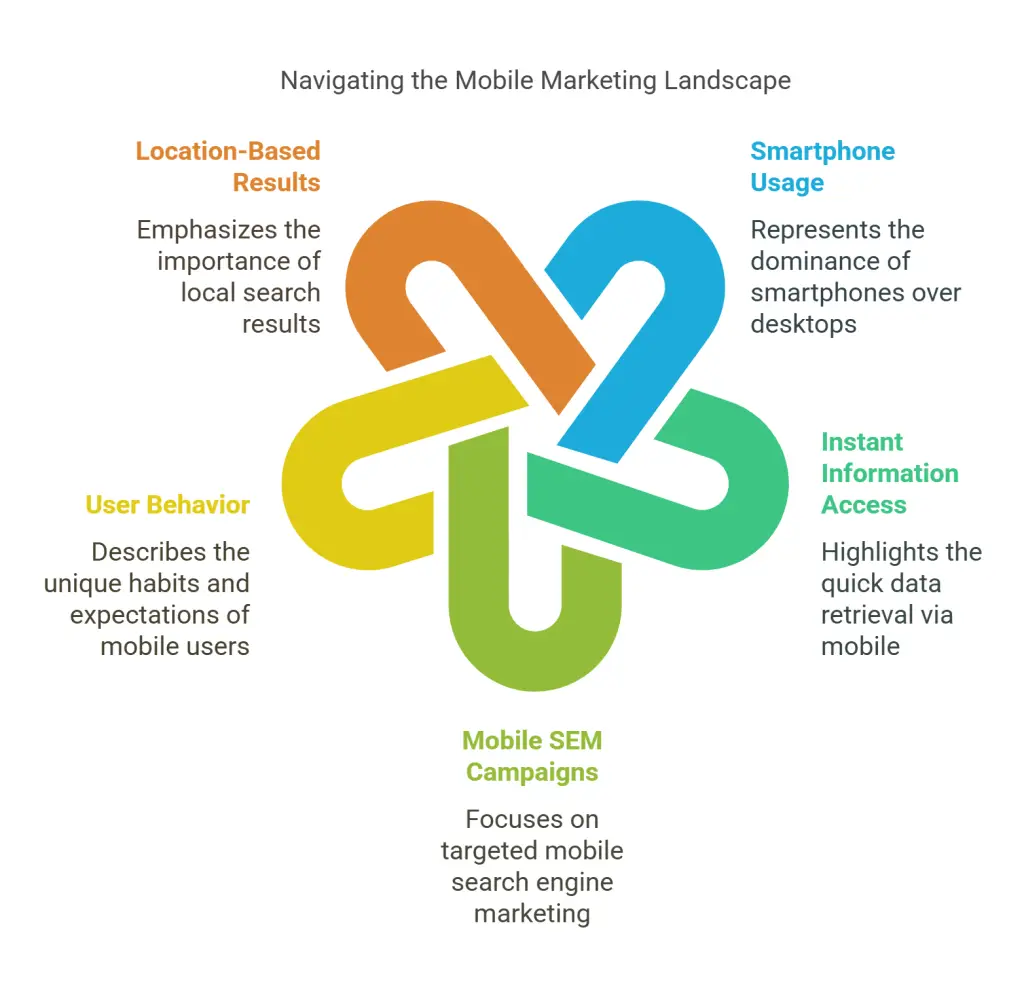
Understanding Mobile SEM Campaigns
Mobile SEM campaigns target specific search queries on smartphones and tablets, enabling brands to display ads in prominent positions when users need them most. While desktop SEM still holds value, mobile ads demand special attention because users viewing them have different intent and constraints. For instance, a smartphone user who searches for “best coffee near me” is likely looking for a quick, location-specific result rather than a general guide that covers an entire region.
The essence of Mobile SEM campaigns lies in making sure your message is concise, relevant, and fits on smaller screens. Ad headlines have to be short, snappy, and offer immediate value. Landing pages must load quickly and present the information the user wants without forcing them to zoom or scroll excessively. In some cases, integrating click-to-call features or app-based campaigns can also be crucial, since many mobile users prefer these direct actions over filling out lengthy forms.
One of the most significant advantages of Mobile SEM campaigns is the opportunity to leverage location data. By focusing on hyper-local marketing, brands can customize ads for audiences nearby. This local element, paired with a well-optimized landing page and targeted keywords, ensures your marketing dollars are spent on reaching audiences who can take quick action—such as visiting a physical store or calling your business directly.
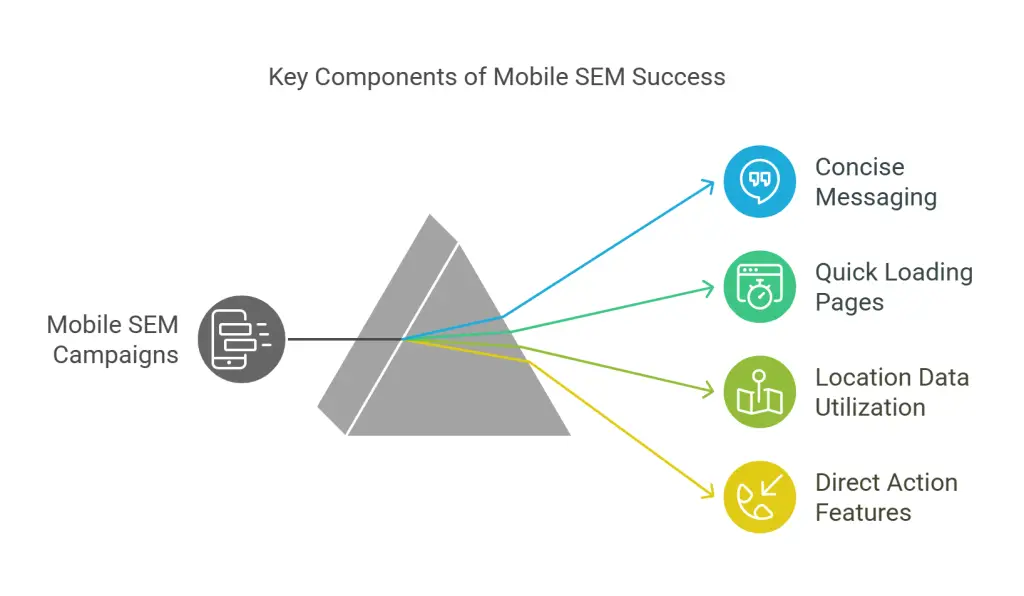
Conducting Keyword Research for Mobile SEM
Keyword research for Mobile SEM campaigns starts with an understanding of how mobile users phrase their queries. Voice search is often used on smartphones, which means queries might be more conversational or longer than desktop queries. Phrases like “Where can I find…” or “How do I…” are more common. To capture these searches, build out a keyword list that incorporates long-tail and conversational phrases, as well as location-based terms.
Tools such as Google Keyword Planner and specialized SEO software can help you identify high-volume, low-competition keywords. Focus on keywords that align with mobile user intent. For example, if you’re a local bakery, terms like “fresh pastries near me” might convert better among mobile searchers. Pay attention to search volumes and cost-per-click data for each keyword, balancing the desire for high volumes with the practicality of staying within budget.
Competitive analysis also plays an essential role. Study how competitors position their ads and the specific keywords they target for smartphones. Identify any gaps in your competitors’ strategies—perhaps they overlook certain neighborhoods or lesser-known local terms—and capitalize on these openings. By carefully selecting, grouping, and refining your keyword lists, you’ll set a strong foundation for high-performing Mobile SEM campaigns that catch the eye of on-the-go consumers.
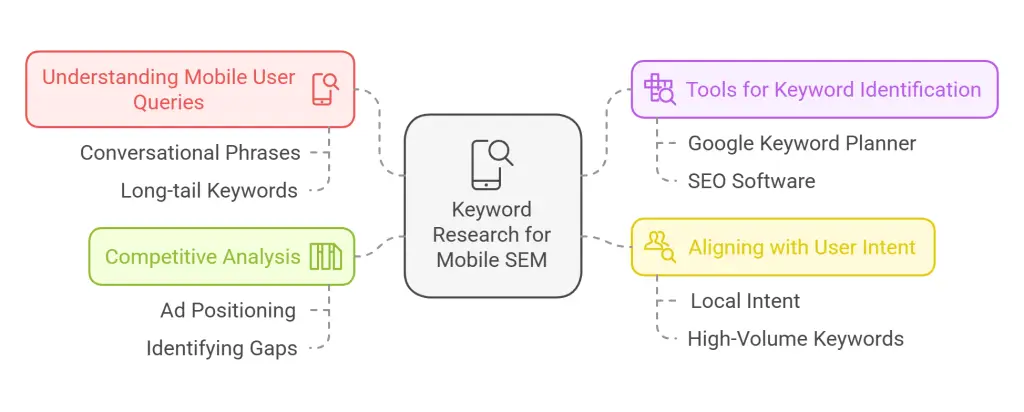
Crafting Mobile-Friendly Ad Copy
Ad copy in Mobile SEM campaigns must be concise yet impactful. With limited screen space, every word should count. Your primary headline should immediately grab attention and make the user feel they’re in the right place. If you sell running shoes, for example, a headline like “Lightweight Running Shoes – 50% Off” might be more appealing than a generic phrase. Offering promotions, discounts, or local store addresses right in the ad can significantly enhance click-through rates.
In your description lines, focus on a clear call-to-action. Because mobile sessions are short, clarity is crucial. Users want to quickly see why they should click on your ad. A relevant call-to-action—such as “Shop Now,” “Call Today,” or “Book an Appointment”—tells them exactly what to do next. Including location tags or service areas also helps, especially for local businesses that need to catch users looking for immediate services.
Ad extensions further elevate mobile campaigns. Sitelink extensions can showcase special deals or direct links to best-selling products, while call extensions allow users to instantly reach you without navigating through your website. If your business relies on foot traffic, location extensions can highlight your address and show directions, reducing barriers between online interest and offline visits. All of these elements contribute to more effective, better-converting mobile ads.

Designing Effective Mobile Landing Pages
Even the most compelling ad copy won’t matter if your landing page is slow or hard to navigate. Mobile SEM campaigns thrive when landing pages load quickly—ideally in under three seconds—and feature a simplified, engaging design. A crucial aspect is ensuring that your landing page meets the promise of your ad. If the ad mentions a discount on running shoes, for instance, the landing page should prominently showcase those discounted shoes without forcing users to click around.
Responsive design is key. This approach allows your landing page to adapt to various screen sizes, ensuring everything from images to call-to-action buttons render seamlessly. The fewer the steps required for a visitor to convert, the better. For e-commerce, offer clear options such as “Add to Cart” or “Checkout” right away. For lead generation, present a short form with minimal fields.
Page speed also affects mobile ad quality scores, which can influence cost-per-click and overall performance. Large images and excessive scripts can lead to slow load times, causing frustrated users to bounce before they’ve even seen your content. Streamline your site, optimize images, and consider using Accelerated Mobile Pages (AMP) if relevant. Doing so creates a frictionless experience that keeps your bounce rate low and your conversion rate high.
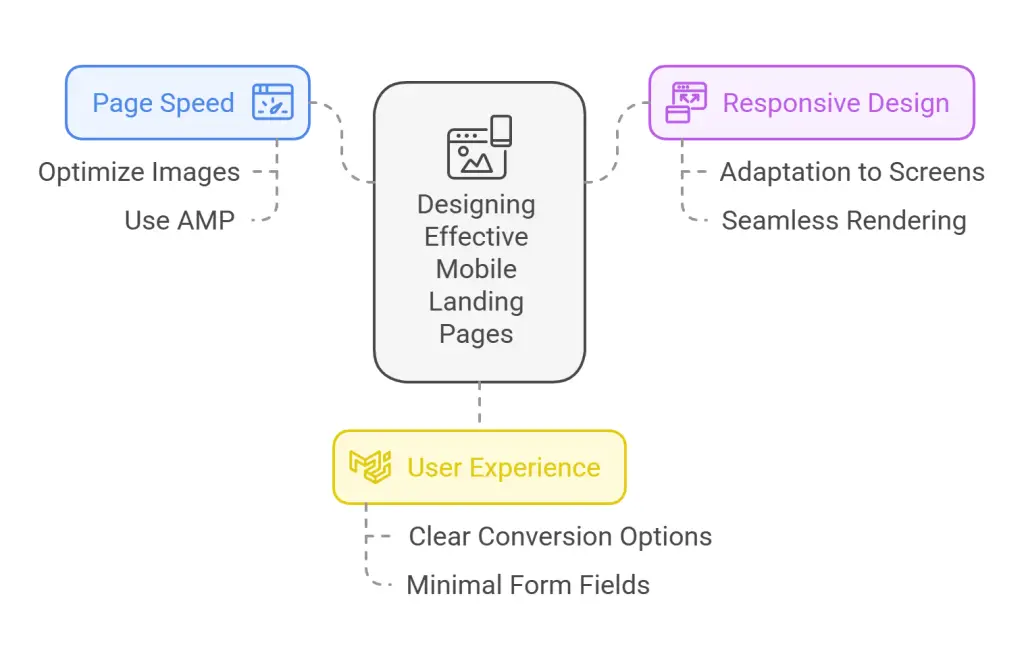
Best Practices for Bidding and Budget Management
Bidding strategies for Mobile SEM campaigns can differ from desktop because mobile competition is often high, yet user intent can also be strongly focused on immediate action. While manual CPC bidding allows you to control maximum bids for each keyword, consider using automated strategies—like Target CPA or Enhanced CPC—once you have enough conversion data. Automated bidding can adjust bids in real-time based on factors like time of day, location, and device, improving your campaign’s overall efficiency.
Budget management ensures your campaigns run smoothly without depleting resources unexpectedly. Start by setting daily or monthly budgets aligned with your marketing goals. For instance, if your aim is to drive foot traffic to a local store on weekends, allocate a higher share of your budget to those days or use ad scheduling to increase bids during peak business hours. Conversely, scale back on times when conversions typically drop.
Monitoring key metrics such as cost-per-acquisition (CPA) and return on ad spend (ROAS) will help you maintain a healthy bottom line. If you notice certain keywords or ad groups consistently failing to convert, consider pausing them or revisiting your ad copy and landing page experiences. This approach keeps your mobile campaigns as cost-effective as possible while preserving the overall quality and relevance of your ads.
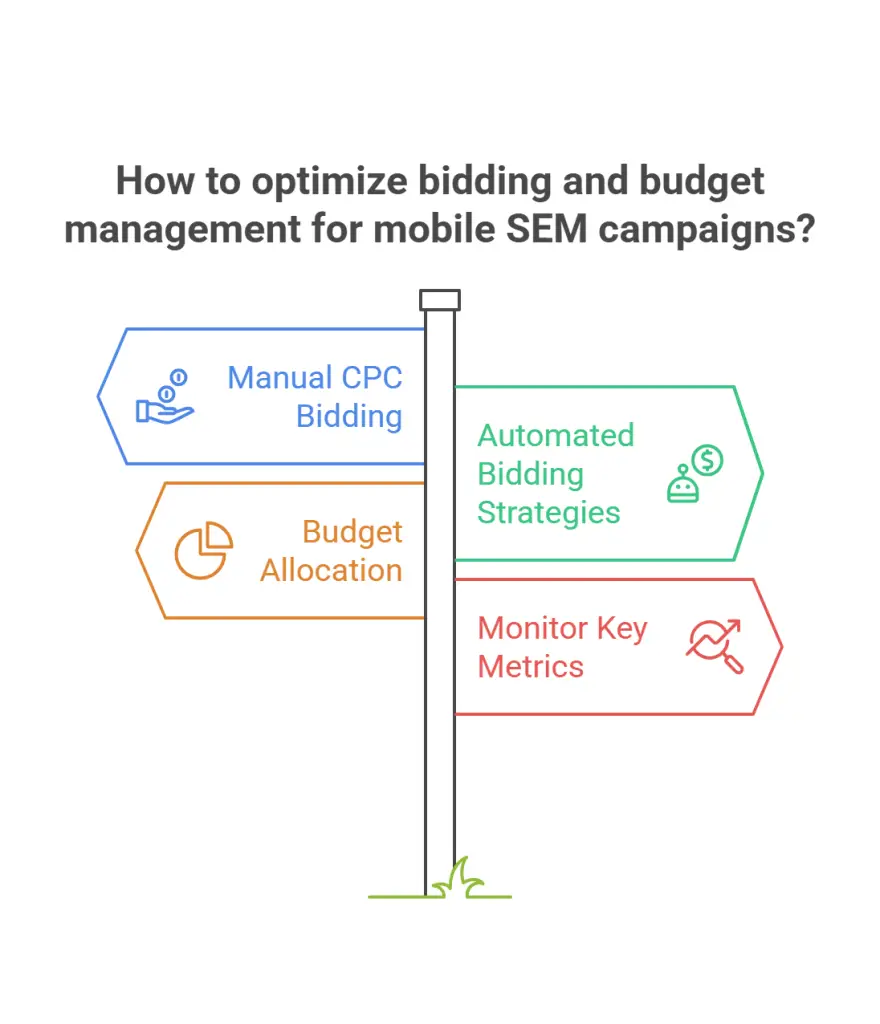
Location-Based Targeting and Ad Extensions
Location-based targeting plays a pivotal role in Mobile SEM campaigns, especially for businesses that rely on local customers. Tools within platforms like Google Ads allow you to narrow down your audience to specific regions, zip codes, or even radii around your brick-and-mortar locations. If you operate a pizza restaurant, you can serve ads to smartphone users who are within a certain distance and searching for “pizza delivery” or “pizza near me.” This localized targeting cuts ad spend waste while zeroing in on searchers most likely to convert.
Ad extensions enhance the power of location-based targeting. Location extensions can show your address and a clickable map. Call extensions let users dial your business instantly without navigating to your site. Structured snippet extensions highlight services or categories, while review extensions can display positive feedback from past customers. Each extension adds an extra layer of credibility and convenience, making it more likely that a mobile user will act.
Combining location data with real-time signals—like local weather or time of day—can further refine your approach. In high foot-traffic moments or during special local events, you can ramp up bids for certain keywords. This kind of micro-targeting ensures your brand stands out right when your local audience needs you, delivering a more personalized, relevant experience.
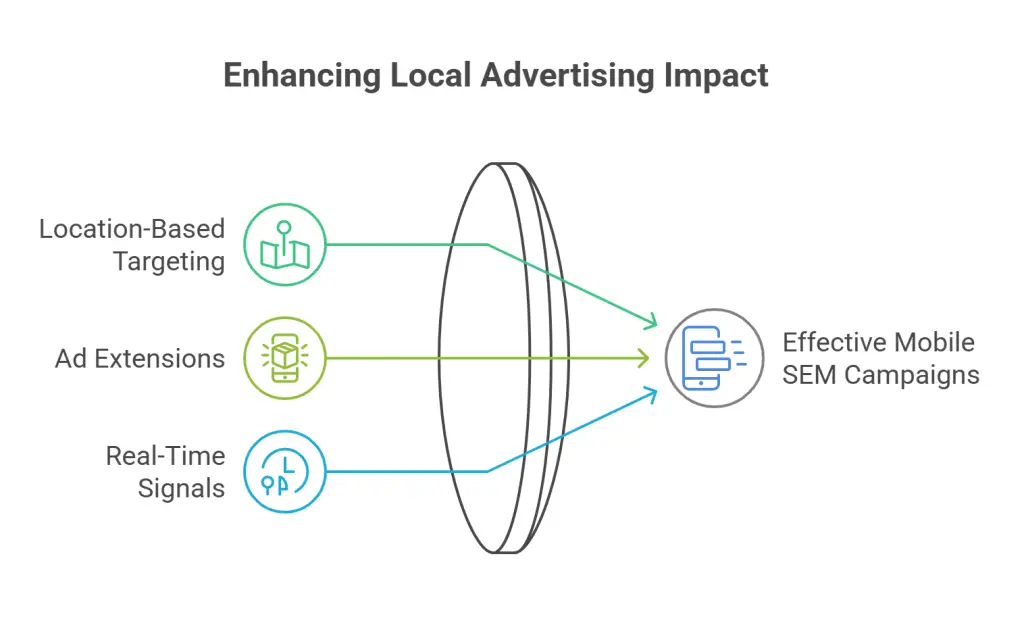
Tracking and Analytics for Mobile SEM
Robust analytics form the backbone of successful Mobile SEM campaigns. Tracking user behavior and conversion paths allows you to understand which ads perform best and why. By integrating Google Analytics or a comparable tool, you can evaluate metrics like bounce rates, session duration, and pages per session for mobile traffic. This data sheds light on whether your campaign is effectively keeping users engaged.
Conversion tracking is particularly crucial. Set up specific goals such as form submissions, phone calls, or completed checkouts. Because mobile visitors may convert in different ways than desktop users, keep an eye on micro-conversions—actions that indicate interest, like signing up for a newsletter or clicking a store locator link. By measuring these smaller steps, you’ll spot opportunities to nurture leads further or refine your ad messaging.
Attribution models also come into play. Users may discover your brand on mobile, compare prices on another device, and finally convert on a third platform. Multi-device tracking helps identify which touchpoints matter most, so you can allocate budgets and bids accordingly. By maintaining a clear view of the entire conversion funnel, you’ll know exactly how each segment of your mobile strategy contributes to revenue, allowing for data-driven optimizations that push results higher over time.
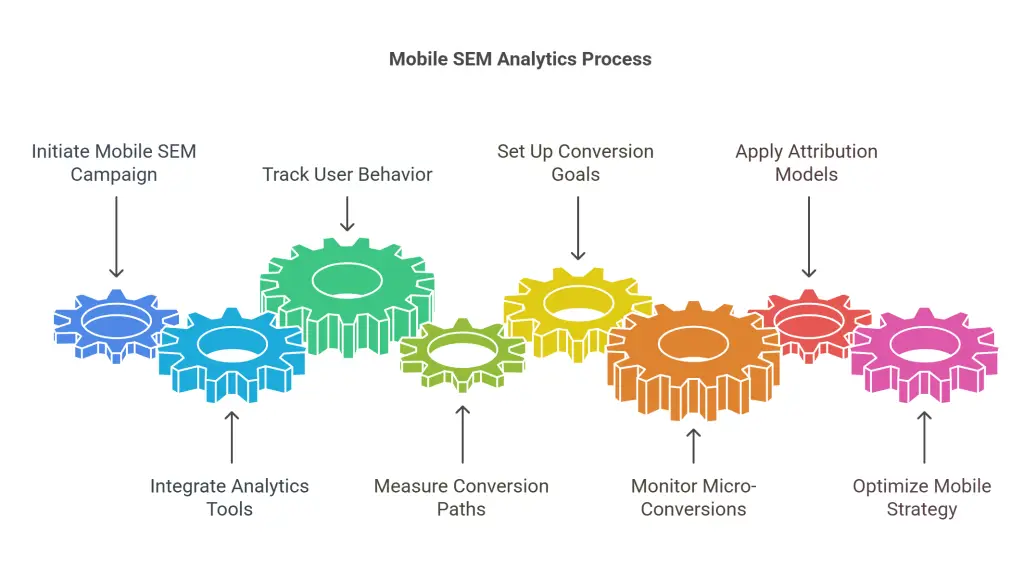
Harnessing the Power of Mobile Shopping and Voice Search
E-commerce brands often see massive gains by focusing on smartphone shoppers. Many consumers are comfortable finalizing purchases on their phones, particularly for products that don’t require extensive research. Mobile SEM campaigns that showcase key benefits—such as free shipping or quick checkout—can tip the scales in your favor. Using shopping ads with high-quality images and relevant product data further streamlines the buying process.
Voice search is another trend that significantly impacts Mobile SEM campaigns. People often speak queries aloud to voice assistants, leading to different keyword structures. Queries become more conversational, such as “Which nearby restaurant has vegan options?” To capture this traffic, incorporate question-like keywords and long-tail phrases in your campaign. Also, crafting content that directly answers common customer questions can help you rank higher for voice-oriented searches.
Optimizing for voice search aligns well with local SEO. Since most voice searches are location-specific, focusing on local keywords, user intent, and structured data becomes vital. Adding schema markup on your website can improve how search engines display your business data, making it easier to appear in voice search results. By blending mobile shopping strategies with an understanding of voice search, you’ll remain front and center for today’s mobile-focused customers.
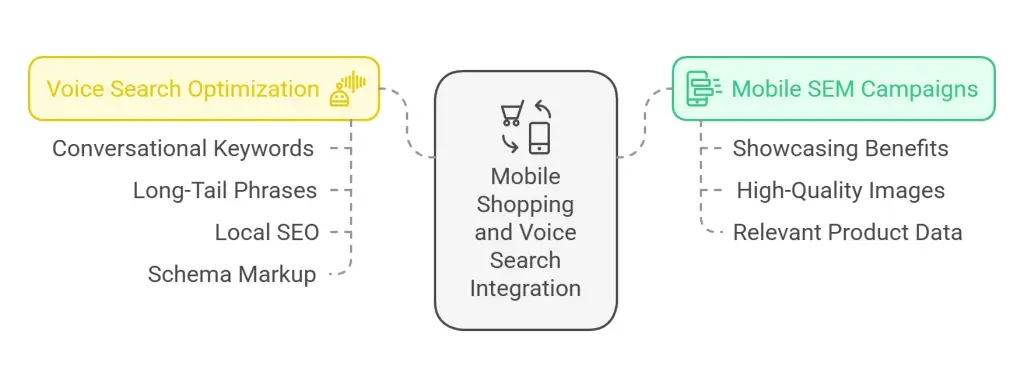
Avoiding Common Mobile SEM Pitfalls
Several common mistakes can undermine the effectiveness of Mobile SEM campaigns. One pitfall is failing to optimize for speed. Slow-loading pages hurt user experience and can negatively impact your quality score, driving up costs. Similarly, cluttered page designs that require excessive scrolling or pinch-to-zoom lead frustrated users to bounce quickly.
Another frequent error is overusing broad-match keywords. While broad match can capture more traffic, it also can bring in clicks from irrelevant queries, draining your budget. Careful use of phrase match or exact match keywords, alongside negative keyword lists, helps maintain relevancy. Evaluate your search term reports regularly to see which keywords drive the right kind of traffic, then refine your lists accordingly.
Insufficient testing is another misstep. Relying on a single ad copy or landing page variant can mean missed opportunities. Test different headlines, images, calls-to-action, and layouts to see what resonates best with mobile audiences. Similarly, not setting up proper conversion tracking can leave you guessing about which aspects of your campaigns truly produce results. Data-driven decisions rely on accurate numbers, so take time to properly configure analytics. By avoiding these pitfalls, your Mobile SEM campaigns will run more smoothly, yielding higher engagement and better returns.
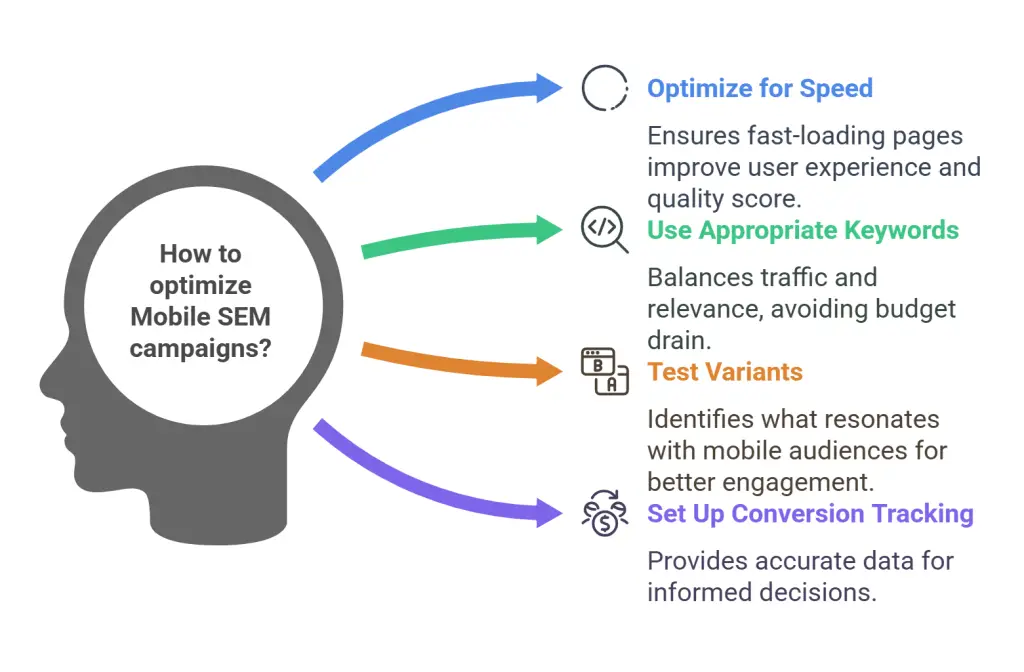
Harnessing Multiple Platforms for Mobile SEM Campaigns
Google Ads is often the cornerstone of many Mobile SEM campaigns, but other platforms like Microsoft Advertising (Bing Ads) and Apple Search Ads can also deliver impressive results. Each platform has its own user base, interface, and targeting capabilities, providing unique opportunities to connect with different segments of your audience.
Microsoft Advertising, for example, may have a slightly older demographic, and often fewer advertisers compete on Bing. This can lead to lower cost-per-click and less competition for certain industries. If you find your target audience using Bing on their smartphones, dedicating part of your budget there might yield higher returns than expected. Apple Search Ads is relevant if you have an app you’re trying to promote to iOS users. By displaying your ad in the App Store when users search for related terms, you can drive immediate downloads from an audience actively seeking new apps.
Consistently analyze results across platforms and compare metrics like cost-per-conversion, click-through rates, and average CPC. These comparisons help guide budget allocation and identify which platform delivers the best performance for your vertical. Diversifying your Mobile SEM campaigns across multiple platforms lets you tap into different user behaviors and demographics, improving overall reach and profitability.
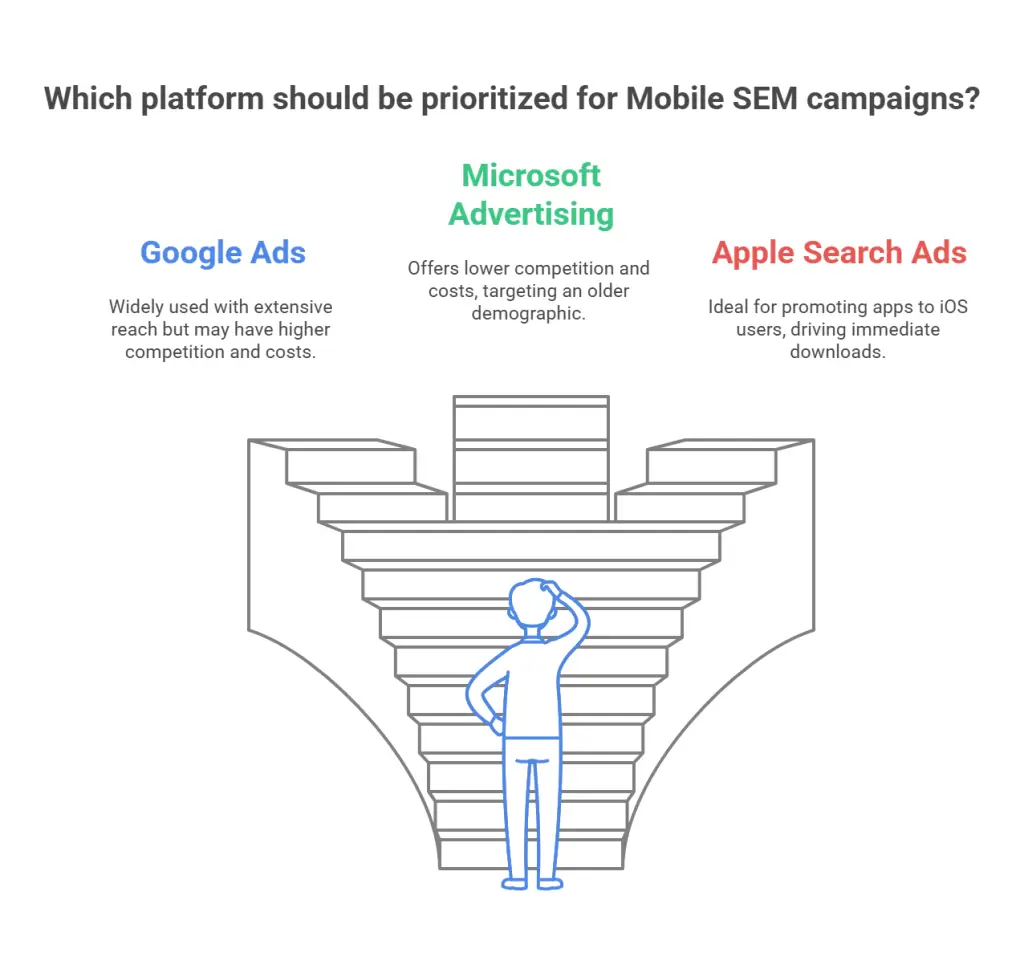
Future Trends in Mobile SEM Campaigns
As technology evolves, Mobile SEM campaigns adapt to meet the changing needs of consumers. One noteworthy trend is the integration of augmented reality (AR) into mobile search experiences. AR elements in ads could let users virtually try on clothing or see how furniture looks in their living space. Such immersive technology significantly boosts engagement, as it addresses user concerns or questions right within the ad experience.
Artificial intelligence and machine learning will continue influencing how campaigns are optimized. Automated bidding strategies already use real-time data to adjust bids, but future enhancements might encompass predictive analytics that can anticipate user intent before the search even happens. Coupled with real-time personalization, these advancements will allow brands to serve highly customized messages to each searcher.
Another area to watch is the expansion of 5G networks, which provide faster internet connections on mobile devices. This shift may encourage the design of more dynamic, content-rich landing pages that can load seamlessly on smartphones. Furthermore, with voice search and digital assistants on the rise, optimizing for conversational queries will remain a priority. Adapting to these trends keeps your Mobile SEM campaigns innovative and aligned with the technology that shapes users’ search habits.
Step-by-Step Guide to Launch a Mobile SEM Campaign
- Define Goals and KPIs: Begin by clarifying what you want to achieve with your Mobile SEM campaigns. Are you driving app installs, online sales, or store visits? Determine which KPIs—like CPA or ROAS—will guide your strategy.
- Conduct Keyword Research: Use tools to find relevant, mobile-focused keywords, including conversational or long-tail phrases. Group them logically into ad groups based on themes or user intent.
- Set Up Campaign Structure: Choose a campaign type (Search, Display, Shopping, etc.) and segment by device targeting if necessary. Ensure your budgets align with the campaign’s importance.
- Create Mobile-Friendly Ad Copy: Keep headlines brief, highlight promotions, and include clear calls-to-action. Add ad extensions such as location, call, and sitelinks where relevant.
- Design Landing Pages: Develop responsive pages that load quickly. Make sure the content matches the ad’s promise and that conversion actions are clearly visible.
- Establish Bidding Strategy: Decide between manual or automated bidding. Monitor and adjust bids based on performance data.
- Implement Tracking: Configure conversions in Google Ads or other platforms. Set up Google Analytics to track user behavior.
- Optimize and Refine: Launch the campaign, gather data, and fine-tune keywords, ads, and landing pages for improved results. Continually test new variations to stay competitive and keep performance metrics strong.
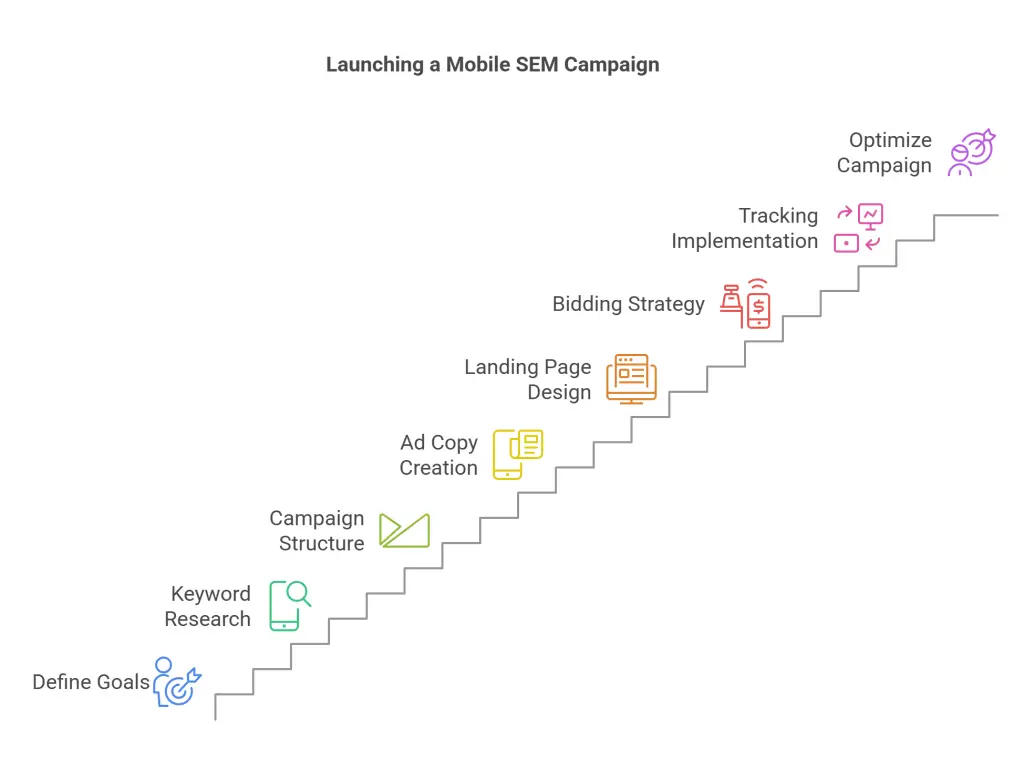
Conclusion
Mobile SEM campaigns are essential for brands that want to remain visible and competitive in an age where smartphone usage dominates daily life. By aligning your strategy with mobile user intent, you ensure that your ads aren’t simply seen but are genuinely relevant to what people need in a specific moment. Everything from keyword choice and ad copy to landing page load time and design elements must cater to the mobile experience.
When these components work together, your brand gains a distinct advantage in capturing the attention of on-the-go users—many of whom are only seconds away from making a purchase or scheduling a service. Implementing location-based targeting, leveraging ad extensions, and continuously analyzing performance data all converge to create a more efficient, profitable campaign. Each step, from preliminary keyword research to ongoing optimization, matters in driving higher click-through rates and conversion rates.
The future of search engine marketing will continue gravitating toward mobile, emphasizing speed, relevance, and personalized experiences. By embracing best practices in Mobile SEM campaigns today, you set a strong foundation for sustainable growth. Whether you run a local store or a global e-commerce brand, tailoring your SEM strategy to mobile user behavior is no longer optional—it’s a core element of long-term success.
Frequently Asked Questions
How do mobile SEM campaigns help businesses?
Mobile SEM campaigns target users on smartphones and tablets through paid search ads. They help businesses reach potential customers at the right moment, increasing engagement and conversions by delivering mobile-optimized ads that cater to on-the-go search behavior.
What are key elements of an effective mobile SEM campaign?
A successful mobile SEM campaign includes mobile-specific targeting, responsive landing pages, click-to-call features, and well-optimized ad copy. These elements ensure ads reach the right audience, provide a seamless experience, and encourage immediate action from mobile users.
Why is mobile ad copy different from desktop ads?
Mobile ad copy must be concise, engaging, and action-driven due to limited screen space. It should include clear CTAs, localized content, and compelling messaging that captures user attention quickly, improving click-through rates and conversions on mobile devices.
How does budget allocation impact mobile SEM campaigns?
Allocating budget effectively in mobile SEM is crucial to maximize ROI. Businesses should prioritize high-performing keywords, adjust bids based on mobile traffic trends, and optimize spend toward peak engagement times to enhance campaign effectiveness and drive conversions.
What role does location-based targeting play in mobile SEM?
Location-based targeting allows businesses to show ads to users based on their geographic location. This strategy helps local businesses attract nearby customers, enhance ad relevance, and improve conversion rates by delivering personalized offers or services in real time.
Further reading
LinkedIn. “Here’s How You Can Optimize SEM Campaigns.” LinkedIn Advice. Accessed March 8, 2025. https://www.linkedin.com/advice/0/heres-how-you-can-optimize-sem-campaigns-uxl1e.
Wetopi. “How to Improve Your SEM Campaigns: Best Practices for PPC Success.” Wetopi. Last modified January 2024. Accessed March 8, 2025. https://wetopi.com/improve-sem-campaigns/.
LinkedIn. “What Are the Most Important Performance Indicators for SEM?” LinkedIn Advice. Accessed March 8, 2025. https://www.linkedin.com/advice/3/what-most-important-performance-indicators-qd15c.
TE Digital Marketing. “7 Tips to Creating a Successful SEM Campaign.” TE Digital Marketing. Last modified March 2024. Accessed March 8, 2025. https://tedigitalmarketing.com/seo/7-tips-to-creating-a-successful-sem-campaign/.
Marketing 360. “How to Set Up Google Ads Campaigns for Success.” YouTube Video. Uploaded February 20, 2024. Accessed March 8, 2025. https://www.youtube.com/watch?v=DfX4Q0jj1k8.
Simplilearn. “How to Optimize Google Ads for Maximum ROI.” YouTube Video. Uploaded January 15, 2024. Accessed March 8, 2025. https://www.youtube.com/watch?v=AtiAlWIw6Zg.


